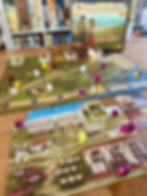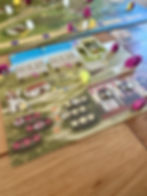WBG Score: 9
Player Count: 1-6
You’ll like this if you like: Lords of Waterdeep, Anachrony, Stone Age
Published by: Stonemaier Games
Designed by: Jamey Stegmaier, Alan Stone
This is the reviewer's copy. See our review policy here
There used to be a T.V. presenter here in the UK whose catchphrase was “oooh I could crush a grape” I’m not sure why. Maybe he was an ex winemaker who was having withdrawal symptoms or perhaps he really liked eating squishy grapes. Either way, I wonder if he’d enjoy Viticulture or if the non squishy glass grape tokens would just upset him? Either way I probably wouldn’t want to play with him if he’s going to get his sticky grape fingers over my cards.

How to make your new favourite vintage.
Everyone takes a player board and components in your colour. Everyone is then dealt two mama cards and two papa cards of which they’ll choose one of each. Mama cards will give you two workers and a choice of cards. Papas will give you your Grande worker and some money. You’ll also have another choice to make on the card which varies per card.
Pick a first player and that player places their cockerel on the wake-up track. Each position awards a bonus except the first space. Each player then does this in clockwise order. The positions on the wake-up track will determine turn order for the round.
The round starts in summer and on your turn you’ll place one of your workers on a space in the summer area of the board and take the action on that space. Depending on player count, some spaces will also grant an extra bonus. Also depending on player count only a certain number of spaces will be available on each action so if all spaces are full then you can’t take that action. However! Each player has a Grande worker which can be placed on an action regardless of if it’s full or not. Players will take actions on the summer section of the board until they decide to pass. When everyone has passed the round will move onto winter. This is much the same as summer but with different actions. Again, players will go until they have passed or run out of workers. It has to be said that if players have spent all of their workers in the summer phase then they won’t be able to take actions in the winter. In general actions will include things like planting vines, harvesting fields, making different wines, selling wines for points and playing cards. At the end of a round, everyone one with grape tokens and wines in their cellar will age them (basically making them better) earn any residuals owed to them (which you get from selling wines), the turn marker will be passed round and off you go again. The game will end at the end of the round where a player has scored 20 or more points. The player with the most points wins.
Can I shock you; I like wine.
The first time I played Viticulture we played it wrong for the entire first half of the game. We were taught that you could only have one wine token in each crush pad at a time and one token for each wine in your cellar. It wasn’t until I questioned why there were so many glass tokens if we were that limited that we checked the rules and corrected ourselves. Needless to say the game went a lot quicker after that. It speaks volumes to me that even after that bodged first half I was still thinking about the game long after that, even to the point where I was tempted to put it in my top ten games!

Viticulture is one of those games that blends its theme and its mechanism together so well, much like the flavours of a fine wine that the game is asking you to create, rather than doing what a lot of games do and largely abstract the process. As an aside I wouldn’t know a fine wine if it came up and poured itself over my head. My process for choosing wine (which I don’t drink) is choosing the one that has the best looking label.
Viticulture goes to great lengths to take you through the winemaking process as best as it can whilst taking out all the boring bits like actually waiting for stuff to grow and harvesting and general hard work. Because it does that the theme oozes out of it like one of the crushed grapes mentioned earlier. Aside from being a worker placement game, Viticulture also throws in some engine building into the mix and, much like most engine builders, it takes a few rounds to get that engine moving. The first rounds of the game can easily make you feel like the game is going to take an age as points ever so slowly drip feed onto the track. But, before you know it the game kicks into gear and you’ll soon be racing to fill orders and keep up with your opponents.
Aye, that’s Grande.
Love them or not, worker placement games can have an unintentional mean side to them. Putting your worker on a space will always elicit cry’s of “No! I was gonna go there.” That’s still true of Viticulture and those cry’s will no doubt get louder if you not only take the space but the bonus as well. I love this game’s ability to scale up and down making it, for me anyway, just as fun and as tight at any of its player counts. But just in case you think that the game is maybe too tight and maybe getting the action you want too difficult, especially if you're the last in turn order, then don’t worry because there’s a Grande ace up Viticulture’s wine sodden sleeve. The Grande worker was added for this essential edition of the game(now the only edition) after people felt the same way. It allows you to take the action of any space even if it’s full. It’s only once per round but this one worker can be an absolute life saver. Not only that, but it really opens your options up when planning. It means that you can do at least one of the things that you really want to get done that round. It may not sound like a lot, but there have been plenty of times where a plan of mine has worked purely because I’ve been able to use the Grande worker. It’s such a simple addition but it’s one that makes a big difference…..that’s probably why it’s called the Grande worker?

The game takes you through two main seasons in which to place your workers and I love how this brings a worker economy element to the whole game. It’s often the source of some painstaking decisions because you’ll most likely want to do a bit of everything. It’s so easy, mainly in your first turns of your first game to just spend all your workers in summer then realise your mistake, but that’s fine because generally you won’t be doing a ton of winter actions on your first round at least. In fact the game has a shifting focus as the game progresses. The first half of the game will mainly be Summer heavy as you try to plant vines, build buildings and essentially build your engine. The second half is definitely more winter focused as you run that engine to make your wines and sell them for those all important victory points. Just because there is a shift though you’ll still find yourself needing spaces from each season in some capacity. Eventually one or two spaces could potentially become pretty much obsolete, which I don’t particularly love. The train you worker space for example once you’ve got all your workers or the plant a vine space will lose its appeal once you got a robust set of vines placed out.
It’s on the cards.
Ignore the cards at your peril in this game. Obviously vine and wine order cards are a must…..or are they? One of the main criticisms thrown at base Viticulture is that you can get a majority of your points from playing the blue or yellow cards negating the need to use that well designed wine simulator. A lot of these cards, especially the blue cards, are more focused on the business of wine rather than the making of it. As much as I’d love to make a compelling case against that, I really can’t. I’ve been in games where this has happened and someone has given me a run for my money by doing just that and almost won the game. It’s a legitimate strategy that can feel good to use but it does kinda pull you out of the theme a bit. It’s like you’ve inherited this winery but rather than using it for its intended purpose you’ve essentially built the Disneyland of the wine loving world. I mean Cadburys world does the same thing but at least they still make the chocolate there. It can be annoying to watch someone win that way, especially if you’ve spent a load of time building up your engine and working up to fulfilling those big orders, only for someone to get a lucky break with cards.

Wakey Wakey
The wake-up track is another clever mechanic. As the player with the grape token (which passes round each turn) you get to put your….cockerel on the board on one of the spaces to determine turn order. Pick first place and you get nothing. Place on any of the other spaces and the further down you go, the better the rewards. So, for example, if you go last you get to take the extra grey worker for that round. It’s a nice little decision to make which could net you some useful bonuses as the round begins. You also never know, just because you're last in to pick a spot, it doesn’t necessarily mean you’ll be last in turn order. I've been in that situation on many occasions but a spot for the first in turn order was still up for grabs.
I mentioned earlier that the game scales well from 1-6 and I’ll happily play it with any of those counts (I won’t get into it here but the solo mode is a lovely challenge) but beware that as the count creeps up so does the game time and with six, especially with someone with a bit of analysis paralysis, then this game could easily trudge on and outstay it’s welcome.
Viticulture is a game that, even after this many plays I’ll never refuse a game of and, probably more importantly, a game that I wouldn’t refuse at any player count. I love the different combination of strategies you can utilise and I love watching that wine engine grow. It probably no surprise to anyone that whilst I couldn’t justify its place in my top ten after half a play. It’s more than justified its place in there now.

